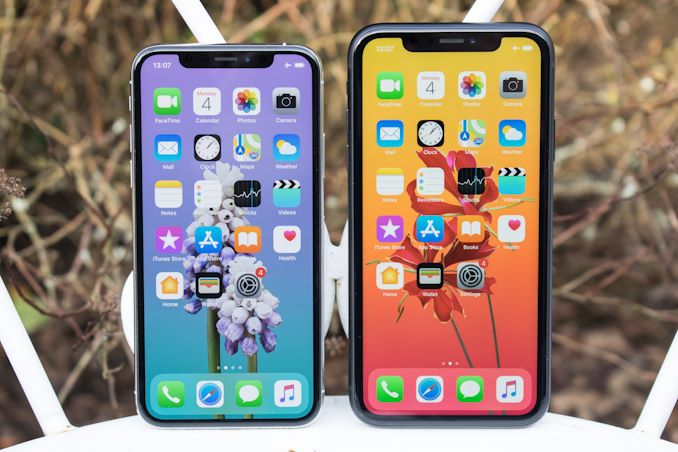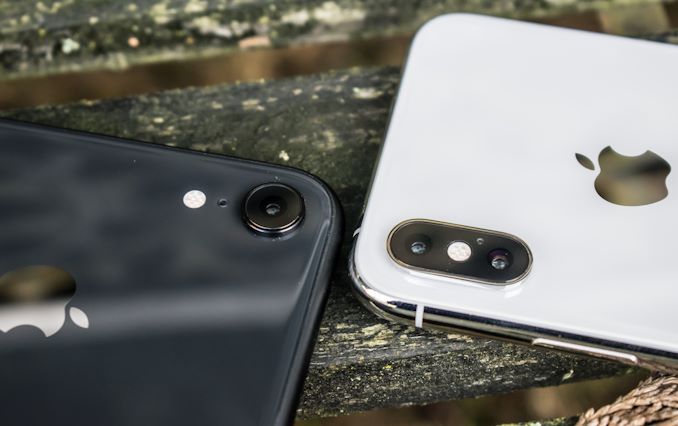The Apple iPhone XR Review: A Different Display Leads To Brilliant Battery Life
by Andrei Frumusanu on February 5, 2019 9:45 AM EST- Posted in
- Mobile
- Apple
- Smartphones
- iPhone XR
Conclusion & End Remarks
The iPhone XR is an interesting phone for Apple simply because of its price positioning. Starting at $749, it’s $250 cheaper than the base iPhone XS, and $350 cheaper than the iPhone XS Max. And this is a gap that continues straight up to the max capacity 256GB models. So the big question here for most users is if the iPhone XR’s differences represent reasonable compromises for the lower price.
From a design standpoint, the iPhone XR comes in the same industrial design as the iPhone XS variants – both of which follow up on the previous generation iPhone X. The big difference here is in the bezels, which are notably larger on the iPhone XR. It does not represent any deal-breaker for the phone and it’s something that I guess most users will get used to – but my gripe is still that with a $749 price tag, the design feels more like something that would have come from a budget smartphone. Apple’s choice of insisting on a symmetric bezel design isn’t something that I personally find appealing in this implementation – but I do know some other users prefer this kind of design over asymmetric bezels (though you could argue the notch makes it asymmetric anyhow…).
The one thing that surprised me the most when using the iPhone XR is that even though it’s a smaller phone than the XS Max, it doesn’t always actually feel all that smaller. Here the increased thickness of the phone does change the in-hand feel quite a lot, and it will feel bigger than you’d expect for a phone with its 75.7mm width.
The main (and most visible) difference between the XR and its XS is inarguably the screen. Among the reasons Apple is able to offer the XR at a cheaper price point is eschewing an OLED panel in favor of a more traditional LCD. In terms of the fundamentals of the LCD in the iPhone XR, Apple continues to employ some of the best panels in the industry, and the iPhone XR is no exception to this. Brightness, contrast ratio (for an LCD), viewing angles, and colour calibration are all top-notch and will not disappoint.
The one area where I think Apple went too conservative is with the display resolution. For the majority of users this will be a subjective matter and it will depend on how they use their phones, but I personally found it among the larger compromises made, and something that would be a deciding factor for me to opt against getting the XR. For anybody else who never use their phones closer than at arm’s length or are less sensitive to the resolution difference, it should not represent any major drawback.
With that said, Apple’s choice to go with an LCD display has a very important side-effect for the iPhone XR: because it avoids the double-edged sword that is a higher-end OLED, it also avoids the technology's higher base power consumption. This increased base power consumption was the reason why the XS Max lasted a notably shorter period of time than the iPhone 8 Plus. The iPhone XR avoids this problem, and in conjunction with the fantastic A12 SoC, the phone is able to achieve Apple’s best ever battery results in our tests. Lasting 25% longer than the iPhone XS Max, this represents a major improvement in battery life and is going to make all the difference for users who value it above everything else. For those users, the cheaper iPhone XR may very well be the better choice.
The performance of the iPhone XR is very much in line with the XS – meaning you’ll be getting an industry leading experience. An important factor for users who value gaming a lot is that, as a side-effect of the lower-resolution screen, the iPhone XR gets better GPU performance and better power efficiency as the phone is only pushing 44% of the pixels of the XS Max. This means longer gaming battery runtimes in current games, and better experiences in future, more demanding games.
The camera on the iPhone XR is pretty straightforward: It’s the same fantastic experience as on the iPhone XS, with the only difference being that it lacks the telephoto lens. Apple’s strengths here are their absolutely great capture experience, which is among the most consistent of current generation smartphones, as well as class-leading picture quality that ties with the best of the competition. Low-light performance is good, but as was the case with the XS, the Android handset vendors have seen immense jumps over the last year due to their usage of computational photography and better sensors, and it’s something that Apple just currently lags behind at.
The lack of a telephoto lens is one of the more justifiable compromises for the lower prices – it’s something that I might miss, but it’s also not a deal-breaker for the phone and I could very easily live without it.
Finally, the big question is if the iPhone XR represents a good value and if it’s a viable choice for users. I think the deciding factor for most users is whether they find the design/ergonomics of the phone acceptable, as well as the display's pixel density. If so, then the iPhone XR certainly seems to represent a better value than the XS alternatives.
Wrapping things up, I find myself coming back to my final paragraph of the iPhone XS review, where I had mentioned that Apple is asking for a lot of money for their new models. At the time I thought that this was a risky pricing strategy for the company, and it seems that Apple is feeling some of the side-effects here as smartphone revenue has dropped year-over-year.
Similarly, I think the iPhone XR is also priced a tad too high, and if you’re not entrenched in the iOS ecosystem, there are better value alternatives. I count myself among those who wouldn’t buy a smartphone at this price, and certainly not if it does compromise on some features. In a way this might be the rationale of more users, and that’s probably why the iPhone XR has seen less demand than anticipated. With hindsight, I see now what I might have been wrong in thinking the XR would be the most popular model of this generation, as it’s not priced low enough to convince users to drop down from what they see as the better long-term investment of an XS variant. That is if they would buy a new iPhone at all this generation, which with the ever increasing prices, is an ever increasingly hard choice to make.












89 Comments
View All Comments
LeftSide - Tuesday, February 5, 2019 - link
Whenever I see an iPhone X, I gave to ask if it’s and XR or and XS. I can’t tell the difference without seeing the back of the phone. I was actually surprised about how good the LCD looks. I’ve been recommending the XR to everyone I know, the cost increase for the higher end models just isn’t worth it.krazyfrog - Tuesday, February 5, 2019 - link
The lack of a telephoto camera and 3D Touch are the real omissions in my opinion. The display is perfectly fine for most people.jakoh - Tuesday, February 5, 2019 - link
How can you not tell the difference in display?Do you use a oled on a daily basis? The oled display on the iPhone is amazing.
krazyfrog - Tuesday, February 5, 2019 - link
I was speaking more in terms of pixel density than panel technology.Stuka87 - Wednesday, February 6, 2019 - link
Just because an OLED is amazing doesn't mean that the TFT isn't fine for most people. The lack of 3d touch, which has been on iPhones for YEARS, is complete BS.mcbhargav - Tuesday, February 5, 2019 - link
I am an XR user, who upgraded from iPhone 7. I found the difference in the first minute. The text is slightly smoother, everything simply is little smooth. But, i am not even a display enthusiast, so i cringed a little and moved on. But, 'perfectly fine' is far from want i think about XR's display. far from!casperes1996 - Tuesday, February 5, 2019 - link
Uhmmm. Your iPhone 7 and the XR had the same pixel densite; @2x. The iPhone 7Plus ran @3x with non-linear scaling.hMunster - Wednesday, February 6, 2019 - link
Non-integer-factor scaling, it was still linear!casperes1996 - Thursday, February 7, 2019 - link
Sorry, yes. That's what I meant of course... Now, finally, I get to join all the people who have said "Where's the edit button please?"levizx - Wednesday, February 6, 2019 - link
So you immediately found "difference" in smoothness of displaying text. Great, now, tell me again how much difference is there between 326ppi and 326ppi?